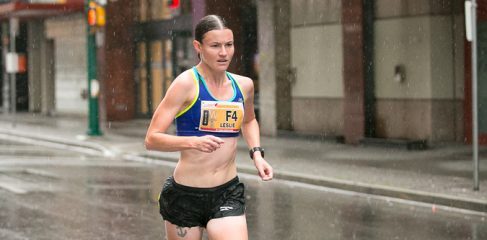
Leslie Sexton’s second place finish at the Toronto Waterfront 10K in June marked a welcome culmination and beginning.
The race closed a long and tedious road back from a sprained ankle that kept Leslie away from racing for six months. The 34:47 finish also marked the beginning of a road back to Leslie’s goals of a personal best at the marathon and of representing Canada on the world stage.
Leslie reports, “I did a 6×1.5K workout the week before on the bike path in London and was able to hit a 3:30/km pace. I figured I would hit about 35 minutes, so I was really happy with the final time.”
“There’s still work to do at this point, but with some more shorter races I think I’ll be ready to get into a marathon build,” Leslie adds. “Part way through, I’ll think about targeting that PB pace and taking a shot at 2:33.”
It’s too early for firm commitments, but Leslie hopes to join the elite Canadian contingent at October’s Scotiabank Toronto Waterfront Marathon (STWM). The race has a special attraction as one where, “I’ve had great results in the past and have always enjoyed because I love racing on home soil.” STWM is where Leslie set her current PB in 2015.
Leslie is used to monk-like patience and acceptance of suffering, welcoming it as part of her training philosophy. She’s a self proclaimed “grinder,” which she defines as “someone who is consistent and puts in the work to get better.”
Regardless of natural talent, the ultimate goal is progress. Leslie says, “I wouldn’t say that I don’t have talent, but I wasn’t a runner who went to the US on scholarship or was the best in the province. It’s always been about making progress and being a bit better each year.”
That philosophy can be put into practice in different ways, but for Leslie the grind is about high volume, including many days with multiple runs. “I just like running and training hard so why would I want to do it only once?” Leslie tells me over the phone.
Following university, Leslie began gradually increasing her volume, which resulted in a significant jump in fitness over time.

Like a true monastic, Leslie finds that pushing through suffering enhances the ecstasy that comes with vocational devotion. Leslie says, “It’s a nice feeling when you can handle the mileage. Sometimes you can be tired and sore so when you get in that zone and still run well it feels great.”
Self-induced suffering is one thing, but involuntary suffering took getting used to. Leslie’s injury was the result of a freak accident and each stage of recovery entailed a different agony. First, it was getting around the house on crutches. Then it was constant flare-up while running. In the midst of winter, turning to the bike trainer for cardio was especially mind numbing and Leslie admits that her neglect of cross training may have delayed recovery somewhat.
Eventually, a new sports doctor nailed down the exercises that Leslie needed for recovery and she poured herself into the new regiment with the same devotion she always gave running. Once conditions improved outside, getting on the bike became easier and could be coupled with running on alternate days.
Post injury, the underlying grinder philosophy helps Leslie remain stoic about the fact that she’s currently chasing times that are far from her best. “I don’t bring ego into it. I don’t care if a sixteen year old beats me. I learned early on how important it is to enjoy the process above everything else,” Leslie says, adding that she brings the same outlook to her coaching.
It’s love of that process that Leslie hopes to never lose. “I’m not looking to be the best ever, but I definitely want to see how far I can push myself as I get older. I want to know how fast I can be at 45,” Leslie explains. “There are so many choices in running and I want to run as long as I can.”
- Ravi Singh





 Current Issue
Current Issue Previous Issue
Previous Issue Prior Release
Prior Release
